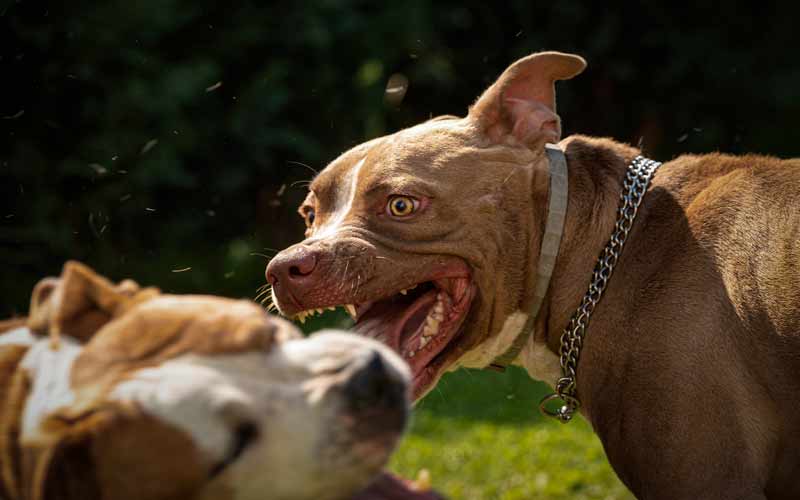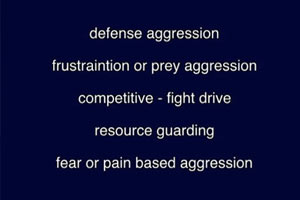Dog Fights and Leerburg's Dominant Dog Collars Don't Go Together

Every day, we get customer questions from our Ask Cindy section. Some of these questions jump off the page because the person really needs help. The post below is a perfect example.
Hello, I need to know if dogs can wear the dominant dog collar in the house, all the time, in case a fight breaks out with another dog in my home. I have 2 large pit bulls that have recently gotten into a couple fights with one another. I am a small woman and unable to separate them on my own if it happens again. I was told that I should have them both wearing the DDC (unless crated) with a short "tab" lead attached to the it. (The ones that are about a foot long.) But after reading the info on the purchase page, I'm not sure if I was advised correctly. Can they be used as a last resort to break up fights by sort of "choking out" out a dog that's gripped in a "death-lock"? Or is their purpose only for walking and training? Can they be worn all day around the house, with a "tab"? (While I'm also at home.) Where can I find FREE info (articles/videos) on proper use of the DDC? I would like to thoroughly educate myself before I attempt to use a new tool to be sure I do so correctly and safely.
This poor woman has two problems. She has been given bad advice on the use of our Dominant Dog Collar (DDC), and she mistakenly thinks a piece of training equipment will solve her very serious dog fight problems.
A DDC was never intended to be used to break up a dog fight, especially with a “tab” line. Not only will it not work, but there is a real risk of the dogs redirecting their aggression back on her. A small woman can easily be killed by two large pit bulls.
Dog owners often do not understand the concept of redirected aggression. When people have a seriously reactive dog, one that shows strong on-leash aggression towards people or other dogs, those dogs are in a crazy state of mind. They are zoned out, some call it the RED ZONE.
When that dog is given a leash correction, there is the possibility the dog will turn and attack the owner. This can happen with a dog that in other situations, would never bite the owner.
In the article I wrote titled How to Break Up a Dog Fight Without Getting Hurt, I explain that the first question every dog owner needs to answer when faced with a serious dog fight is “Am I physically strong enough to deal with this situation?”
If the answer is “NO” or “I AM NOT SURE”, then they need to go get help, or if help is not close by they, unfortunately, need to let the dogs fight it out. The bad thing with two large pit bulls is this may end badly because one of the dogs could be killed. As terrible as that is, it's better than the two of them turning and redirecting on her.
Don't for a second think this could not happen with any number of large breed dogs. It is most definitely not a breed-specific phenomenon that can only happen with pit bulls.
This brings us to her second problem, proper management. Once dogs like this have fought, the odds of training them not to fight is probably not going to happen.
The solution is to only allow one dog at a time to be loose in the house. This means the second dog is in a sturdy dog crate or a dog kennel. The key here is this needs to happen for the rest of these dog's lives.
The second thing the woman should consider is to train her dogs to wear a sturdy muzzle. She first needs the correct muzzle. She also needs to learn how to put that muzzle on the dog so it will not come off. When muzzles are not sized correctly or not put on the dog correctly, they will come off. We already know what happens then.
If she is not comfortable with her ability to deal with muzzles then she needs to either walk the dogs separately by themselves or rehome one of the dogs.
I have owned dozens of dogs for over 50 years. I can't even count the number of dogs I have had in my life that I could never allow them to be together. My solution was management. 99% of the time, I simply had one-on-one time with the dogs by themselves.
Unfortunately, I often have to tell new dog trainers that just because they want to do something, or they want to live in a certain way with their dog (or dogs) doesn't mean it's possible.
Important Note About Dominant Dog Collars
When a DDC is sized correctly and used correctly, they are an excellent substitute for a prong collar. Not because prong collars should never be used, they too have a place in training some dogs.
However, prong collars on reactive dogs often become a problem. They overstimulate the dog and once again, could cause redirected aggression. A dominant dog collar on these dogs is often a better solution.











Ask Cindy.